1885 Hen Egg/First Hen Egg
Presented
by Alexander
III to Maria Feodorovna
Made in Saint Petersburg
Owner: The Link of Times Foundation, Russia
Height: 6,4 cm
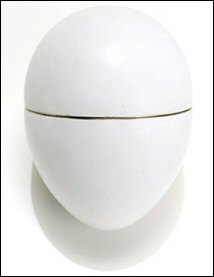
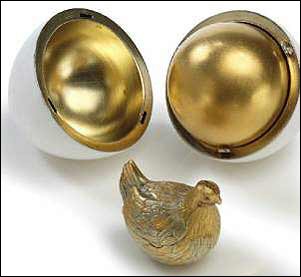
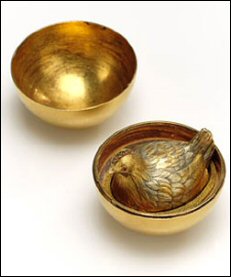
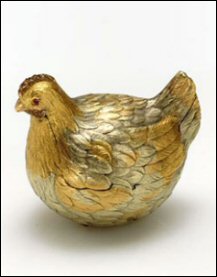
(Courtesy www.treasuresofimperialrussia.com)
The First Hen Egg is made of gold, opaque white enamel, rubies and varicolored gold. The now missing surprises were a crown and a pendant, made of diamonds and ruby. The first Easter Egg of 1885 marks the twentieth anniversary of Tsar Alexander III and Tsarina Maria Feodorovna. The Tsar needed a special gift for his young bride, the Danish Princess Dagmar, and he ordered a special Egg with the young jeweler Peter Karl Fabergé, whose beautiful creations recently caught Maria's eye.
The gold shell of this simple but historic Egg is enameled opaque white and polished to resemble a hen's egg. The two halves open to reveal a matt gold yolk, containing a varicolored gold hen with ruby eyes. Originally contained within was a diamond replica of the imperial crown, which concealed a tiny ruby pendant. (see below).
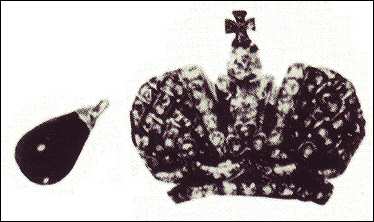
The crown and the ruby pendant
(Courtesy www.treasuresofimperialrussia.com)
Background information
This Egg is a variation on an egg in the Danish Royal Collection, which Fabergé probably saw during his travels through Europe. Whether is was Fabergé's or the Tsar's idea to create this Egg, Maria was deeply touched and a tradition started that would last for 30 years, until the Russian Revolution in 1917.
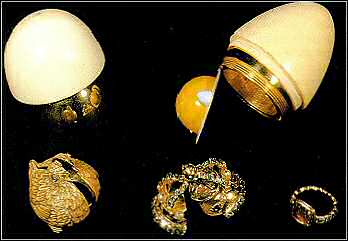
(Private postcard)
The Easter Egg in the Royal Danish Collection. Made in the first half of the XVIII century. Inside the golden hen with diamond eyes, a diamond-set crown. Inside the crown a ring, also set with diamonds.
In the 1920's the First Hen Egg was sold by Russian officials to a dealer in Paris or Berlin. 1934 sold by Christie's (London) to Mr. Suenson-Taylor, later known as Lord Grantchester. In 1976 acquired by A La Vieille Russie, New York. 1978 sold in a private sale to Malcolm Forbes, The Forbes Magazine Collection, together with the Imperial Resurrection Egg. February 2004, sold by the Forbes family, together with 8 other Imperial Eggs and many other Fabergé works, to the The Link of Times Foundation, Russia.
Update Januari 2019
Last year it was rumored that another 1885 First Egg was discovered in Russia. The egg described above however, was recognised by Fabergé's London branch manager, Henry Bainbridge, in the auction in London in 1934. He wrote about this in a letter to Faberge's son Eugène on March 13, 1934:
"Dear Eugène,
... As I told you there are none of the Imperial eggs on the sale except the original one like a hen's egg ..." (The Fabergé imperial Easter eggs - Tatiana F. Faberge, Valentin V. Skurlov, Lynette G. Proler - 1997 page 79)
As there can only be one Imperial Easter Egg, I go for the provenance of the above described Egg and the words of Henry Bainbridge.
aw 2 januari 2019
Images:
Read more: http://www.treasuresofimperialrussia.com/e_chap1_hen.html - Link no longer active.
page updated: January 2, 2019
